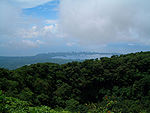
Islets of Granada
Encyclopedia

Lake Nicaragua
Lake Nicaragua or Cocibolca or Granada or is a vast freshwater lake in Nicaragua of tectonic origin. With an area of , it is the largest lake in Central America, the 19th largest lake in the world and the 9th largest in the Americas. It is slightly smaller than Lake Titicaca. With an elevation...
, just southeast of the city of Granada
Granada, Nicaragua
Granada is a city in western Nicaragua and the capital of the Granada Department. With an estimated population of 110,326 , it is Nicaragua's fourth most populous city. Granada is historically one of Nicaragua's most important cities, economically and politically...
in Nicaragua
Nicaragua
Nicaragua is the largest country in the Central American American isthmus, bordered by Honduras to the north and Costa Rica to the south. The country is situated between 11 and 14 degrees north of the Equator in the Northern Hemisphere, which places it entirely within the tropics. The Pacific Ocean...
. The islets are a group of 365 small islands scattered about the Asese peninsula. The islets are of volcanic origin, they were formed when the Mombacho
Mombacho
Mombacho is a stratovolcano in Nicaragua, near the city of Granada. It is 1344 metres high. The Mombacho Volcano Nature Reserve is one of 78 protected areas of Nicaragua. Mombacho is an active volcano but the last eruption occurred in 1570...
volcano blew most of its cone into the lake over 20,000 years ago, thereby creating the archipelago
Archipelago
An archipelago , sometimes called an island group, is a chain or cluster of islands. The word archipelago is derived from the Greek ἄρχι- – arkhi- and πέλαγος – pélagos through the Italian arcipelago...
. Most of islets are covered with unusual vegetation
Vegetation
Vegetation is a general term for the plant life of a region; it refers to the ground cover provided by plants. It is a general term, without specific reference to particular taxa, life forms, structure, spatial extent, or any other specific botanical or geographic characteristics. It is broader...
, and are rich with bird life.
Many of the islets are occupied. Some are privately owned and hold homes or vacation houses. There are facilities for the residents and for tourists. Hotels and shops are established on some of the islets, and boating tours are available.

